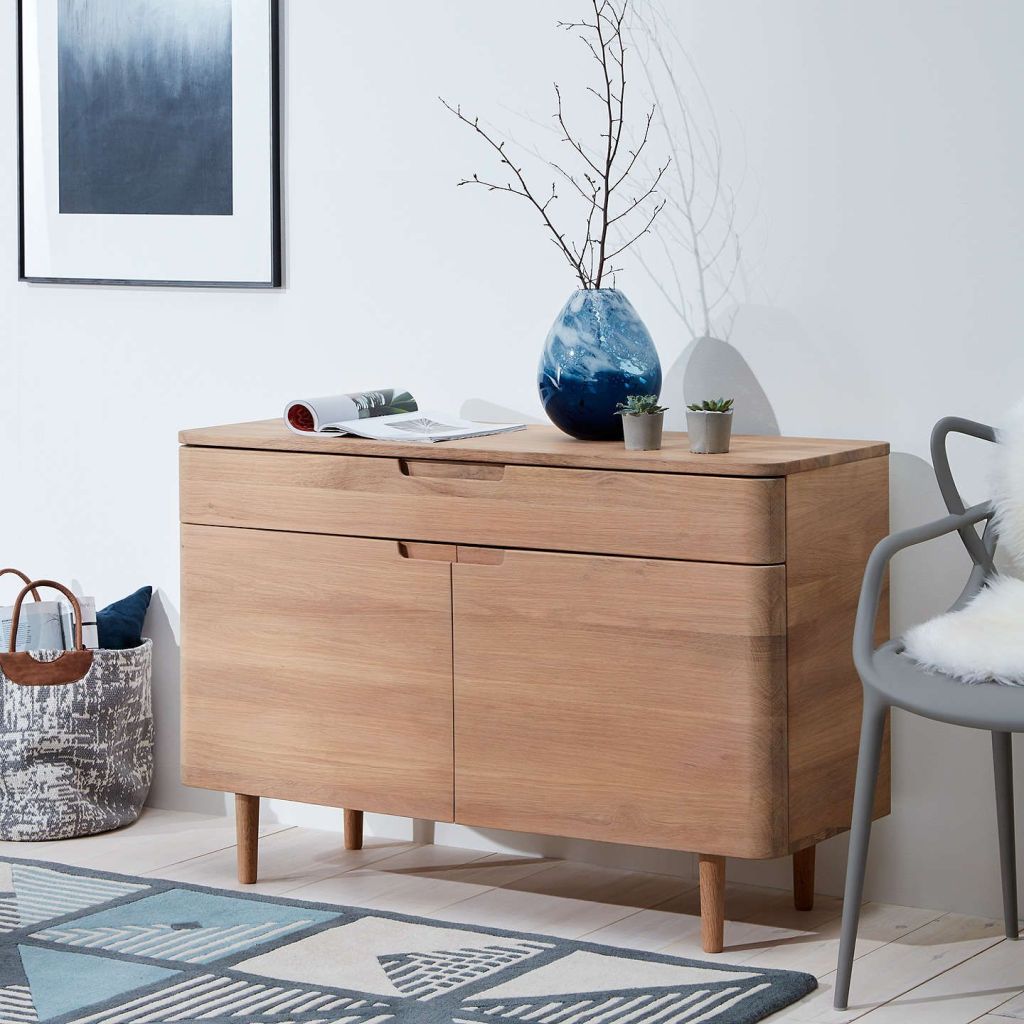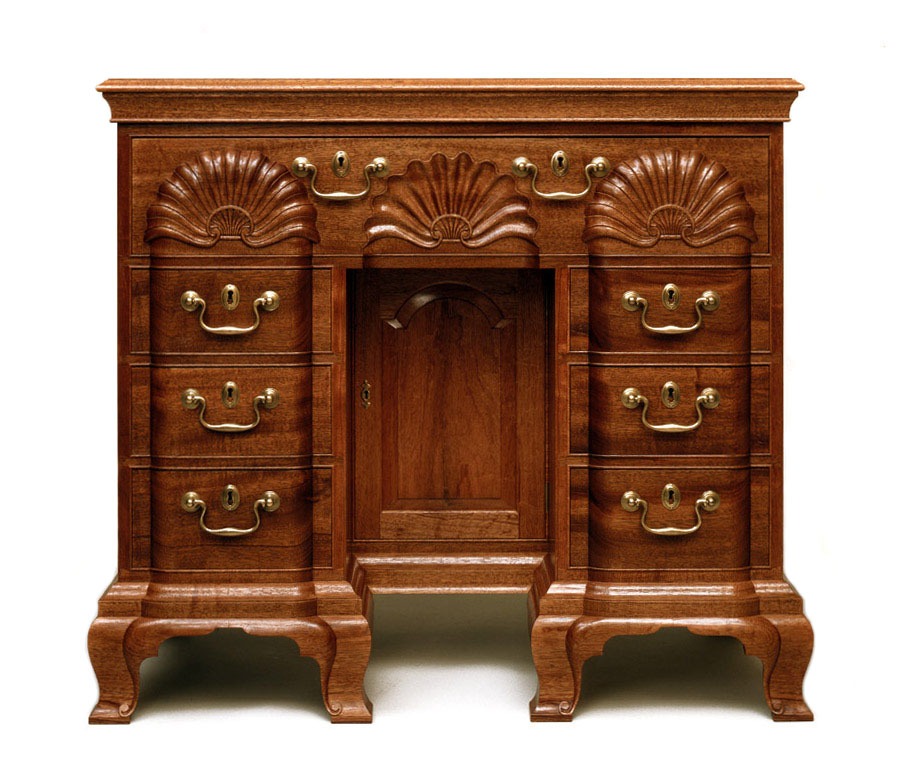
Carl-Axel Acking (1910-2001) was a prominent architect, and interior and industrial designer, who was particularly active during the 1940s and 1950s. He is remembered for his important contribution to modernist architecture and design in Sweden.
Education
From 1931 to 1934, he studied at the National College of Art in Stockholm, then at the Art School and the Royal Institute of Technology in Stockholm, graduating in 1939.
Biography
In the 1930s, he worked as Gunnar Asplund’s assistant. In 1939, set up his design studio. Between 1943-64, he taught at Konstackskolan and 1964-76, Tekniska Skolan in Stockholm and the Tekniska Högskolan, Lund. He was the architect of the Swedish Embassy in Tokyo and the interior designer of ships of the North Star Line. He designed (with others) the 1955 ‘H 55’ exhibition, Hälsingborg. In 1949, designed furnishings for Hotel Malmen, Stockholm.
Furniture
Seating and storage pieces made up the majority of Acking’s furniture design. His most famous designs include the Anette dressing table (1943) for Nordiska Kompaniet (NK); the Bentwood Chair (1944) —a chair assembled from just ten pieces which Acking hoped would be both practical for a modern family and suitable for mass production; the Trienna Chair (1957) for NK—named after Milan’s Triennale, where the chair was exhibited; and the Tokyo Chair (1959)—originally designed for the Swedish Embassy in Tokyo. Acking experimented with designing lighting, textiles, and cabinets throughout his career.
Mid-Century Swedish Cabinet by Carl-Axel Acking

The Scandinavian Modern Cabinet in two-tone birch and walnut with beautiful inlay on the front doors is a stunning piece of furniture that will elevate any room it’s placed in. The sleek lines and minimalist design are characteristic of the Scandinavian style, emphasising functionality and simplicity. The two-tone finish adds visual interest and warmth to the piece, while the intricate inlay on the front doors adds a touch of elegance and sophistication. Overall, this Scandinavian Modern Cabinet is a timeless piece that will stand the test of time and be cherished for years.
Sources
Byars, M., & Riley, T. (2004). The design encyclopedia. Laurence King Publishing. https://amzn.to/3ElmSlL
More on Furniture Design
Ross Franklin Littell (1924 – 2000) American Textile and Furniture Designer
Ross Franklin Littell (1924 – 2000) was an American textile and furniture designer known for his practical, innovative, and minimalist…
Keep readingAlessandro Becchi: Icon of Italian Furniture Design
The Anfibio Sofa, designed by Alessandro Becchi in 1971, exemplifies Italian radical design with its multifunctional, sculptural form, merging comfort…
Keep readingBruno Ninaber van Eyben: Designing Time and Currency in the Netherlands
Bruno Ninaber van Eyben, a prominent Dutch designer, is known for his minimalist approach in creating everyday items like watches…
Keep readingGiotto Stoppino: An Icon of Italian Postmodern and Neo-Liberty Design
Giotto Stoppino was a key figure in Italian design, fusing modernism with postmodernism, exemplified by his iconic works like the…
Keep readingWarren McArthur: A Pioneer of Modern Furniture Design
Warren McArthur was a pioneering designer who transformed furniture design through innovative use of tubular metals and modular systems, influencing…
Keep readingCelebrating the Work of Simo Heikkilä: A Finnish Design Icon
Simo Heikkilä, a Finnish designer, blends industrial aesthetics with comfort, notable for his teaching and innovative designs, including the acclaimed…
Keep readingKey Features of Stickley Furniture Design
Gustav Stickley, a key figure in the Arts and Crafts movement, pioneered simplistic, functional furniture design, merging craftsmanship with natural…
Keep readingPro Finlandia – Order of the Lion of Finland
The Pro Finlandia Medal, established in 1943, honors artists and writers for their contributions to Finnish culture, showcasing the nation’s…
Keep readingEbbe Gehl: Icon of Scandinavian Furniture Design
Ebbe Gehl (1943–2023) was a renowned Danish furniture designer known for blending simplicity, functionality, and traditional craftsmanship, significantly impacting modern…
Keep readingFurniture Design 1940 to the Present in the United States
The evolution of American furniture design since 1940 showcases a shift from traditional craftsmanship to modernism, driven by technology and…
Keep readingFrom Geologist to Furniture Designer: Sergio Savarese’s Journey
Sergio Savarese (1958–2006) was an influential Italian furniture designer who co-founded Dialogica, merging classical styles with vibrant designs, leaving a…
Keep readingExploring Goddard and Townsend: Newport’s Cabinetmaking Legacy
The Goddard and Townsend families, renowned Quaker cabinetmakers in 18th-century Newport, created the distinguished Newport furniture style, blending craftsmanship with…
Keep readingFrank Gehry: Visionary Architect of Deconstructivism
Frank O. Gehry, a Canadian architect, is renowned for his innovative, sculptural designs that challenge norms, significantly influencing contemporary architecture…
Keep readingFrank Gehry’s Power Play Armchair: Transforming Design
Frank Gehry’s Power Play Armchair exemplifies innovative design, merging art and function, challenging material norms, and transforming mundane materials into…
Keep readingAldo van den Nieuwelaar: Pioneer of Minimalist Design
Aldo van den Nieuwelaar was a Dutch minimalist designer influential for his geometric works, including the TC6 lamp and A’dammer…
Keep readingRonan Bouroullec: Master of Contemporary Design
Ronan Bouroullec, a prominent French designer, has collaborated with his brother Erwan, blending functionality and aesthetics, significantly influencing contemporary design…
Keep readingVersatile ‘Passage’ Chair: Design Meets Functionality
The ‘Passage’ chair by Ronan Bouroullec combines modern aesthetics with sustainability, featuring customizable options and a versatile design for various…
Keep readingFSC Certification: Types and Benefits Explained
FSC certification promotes responsible forest management, ensuring products benefit the environment, society, and economy, while enabling consumers to make sustainable…
Keep readingWerner Aisslinger: Pioneer of Innovative Design
Werner Aisslinger, a German designer, is known for innovative furniture and architecture, emphasizing sustainability and emotional spaces in his notable…
Keep readingIlmari Tapiovaara: Master of Finnish Design
Ilmari Tapiovaara was a Finnish designer known for functionalist furniture that harmonizes aesthetics and practicality. His influential works include the…
Keep readingArne Vodder: A Legacy in Scandinavian Mid-Century Design
Arne Vodder, a key figure in Scandinavian mid-century design, is known for his timeless furniture creations, emphasis on natural materials,…
Keep readingJørgen Gammelgaard (1938-1991): Pioneering Danish Design Master
Jørgen Gammelgaard (1938-1991) was a pivotal figure in Danish design, known for minimalist furniture and lighting designs blending form and…
Keep readingA Collection of Design for Household Furniture by George Smith
George Smith’s influential work, “A Collection of Designs for Household Furniture and Interior Decoration,” captures Regency era’s stylistic preferences and…
Keep readingJean Burkhalter: The Renaissance Man of Art Deco Design
Jean Burkhalter, a pioneering figure in Art Deco, showcased versatile creativity in textiles and decorative arts, leaving a timeless legacy…
Keep readingMartin Eisler and the Mid-Century Design Movement
Martin Eisler, a key figure in mid-century modern design, seamlessly blended European tradition and Latin American innovation. His journey and…
Keep readingDenham McLauren: Mastering Modernism in British Furniture Design
Denham McLauren, a trailblazing British furniture designer, seamlessly integrated traditional craftsmanship with modernist elements. His innovative use of materials and…
Keep readingErwine and Estelle Laverne: Pioneers of Mid-Century Modern Design
Erwine & Estelle Laverne were influential mid-century American designers, blending art and functionality in minimalist furniture. Their legacy endures despite…
Keep readingThe Herter Brothers and Their Mark on the Gilded Age of American Design
The Herter Brothers, pioneers of American decorative arts, shaped the opulent Gilded Age aesthetic through integrated interior design and influential…
Keep readingGianfranco Frattini: A Master of Modern Italian Design
Gianfranco Frattini (1926-) was a key figure in Italian design, known for his contributions to architecture and industrial design, leaving…
Keep readingIntroduction to Philippe Tabet: A Connoisseur of Material and Form
Philippe Tabet, a renowned artisan, bridges traditional craftsmanship with industrial innovation in design, showcasing a deep connection to materials and…
Keep readingAdelmo Rascaroli: Bridging the Past and Present in Italian Design
Adelmo Rascaroli, an influential Italian architect and designer, made significant contributions to 20th-century design, particularly in furniture. His work reflects…
Keep readingWilhelm Kienzle: Mastering Minimalism and Functionality through the Iconic Safari Chair
Wilhelm Kienzle, a pioneering Swiss designer of the 20th century, is renowned for his iconic safari chairs, reflecting minimalism, functionality,…
Keep readingJoris Laarman: Sculpting the Future with Technology and Design
Joris Laarman, a Dutch designer, merges art, technology, and design in innovative ways, pushing the boundaries with digital technologies and…
Keep readingCrafting Elegance in Everyday: The Artistry of Monika Mulder
Monika Mulder, a Dutch furniture designer, draws inspiration from nature, creating playful yet functional designs and receiving international acclaim for…
Keep readingPaul T. Frankl: The Architect of American Modernism and the Skyscraper Style
Paul T. Frankl, an Austrian-born designer, pioneered American modernism with his iconic Skyscraper style furniture, founding AUDAC, and embracing innovation…
Keep readingNiels Gammelgaard: Master of Minimalism and Functionality in Danish Design
Niels Gammelgaard, a Danish design icon, left an enduring legacy with his simple, practical creations. His diverse collaborations and products…
Keep readingThe Timeless Elegance of the Nelson Platform Bench: A Fusion of Form and Function
The Nelson Platform Bench, designed by George Nelson, embodies timeless beauty and utility, showcasing exceptional craftsmanship and versatility that transcend…
Keep readingCharles Wilson: The Symphony of Form, Function, and Nature in Australian Design
Charles Wilson, a Sydney-based designer rooted in rural New South Wales, creates functional art honoring natural materials. His designs blend…
Keep readingThe Art of the Curious: Marc Newson’s Cabinet of Curiosities for Louis Vuitton
Australian designer Marc Newson collaborates with Louis Vuitton to create a modern Cabinet of Curiosities, redefining luxury storage and personal…
Keep readingThe Vermelha Chair: A Symbol of Chaos and Craftsmanship
The Vermelha chair by Fernando and Humberto Campana symbolizes innovation, craftsmanship, and cultural expression. It challenges norms and blends traditional…
Keep readingThe Bodice Rocker by Splinter Works: A Symphony of Design, Comfort, and Illusion
Splinter Works introduces the Bodice Rocker, a sculptural chaise-longue challenging perceptions of balance and comfort. Customizable and defying gravity, it’s…
Keep readingMingyu Xu: A Bridge Between Tradition and Innovation in Furniture Design
Mingyu Xu Studio combines traditional bamboo weaving with modern design, emphasizing sustainability. Xu’s journey and accolades shape a unique, culturally-informed…
Keep readingErnő Goldfinger: A Pillar of Modernist Design
Ernö Goldfinger, born in Budapest in 1902, shaped modernist architecture through iconic designs like the Trellick Tower and innovative furniture…
Keep readingEames House Bird – Mid Century Adornment
The collage-like interior of Charles and Ray Eames’ private house, the Eames House, was supplemented with countless objects and accessories…
Keep readingThe Artistry of Lee Broom: A Modern Maestro of Design
Lee Broom, a pioneer in luxury furniture and lighting, integrates traditional craftsmanship with modern elegance, redefining design and inspiring future…
Keep readingRoald Steen Hansen: A Confluence of Danish Design and Craftsmanship
Roald Steen Hansen: A Danish design icon known for timeless furniture, exhibitions in Munich and Viborg, and numerous accolades and…
Keep readingAntoni Gaudí – A Maestro of Chair Design
Antoni Gaudí’s revolutionary furniture designs, such as the Calvet armchair and Batlló chair, unite form, function, and aesthetics in innovative…
Keep readingAndré Verroken – A Symphony of Absurd Logic and Functional Artistry
André Verroken, an award-winning designer, challenges traditional perceptions with his furniture designs, embodying utility and aesthetic appeal through a philosophical…
Keep readingAlvar Aalto’s Model No. 41 Lounge Chair”
Alvar Aalto’s “Model No. 41” lounge chair, designed between 1929 and 1933 for the Paimio Sanatorium, exemplifies his commitment to…
Keep readingPaolo Deganello: Pioneering Radical Design
Paolo Deganello, a key figure in radical architecture and design, reshaped Italian design through innovative furniture and collaborations, leaving a…
Keep readingRelated articles
Discover more from Encyclopedia of Design
Subscribe to get the latest posts sent to your email.

















































